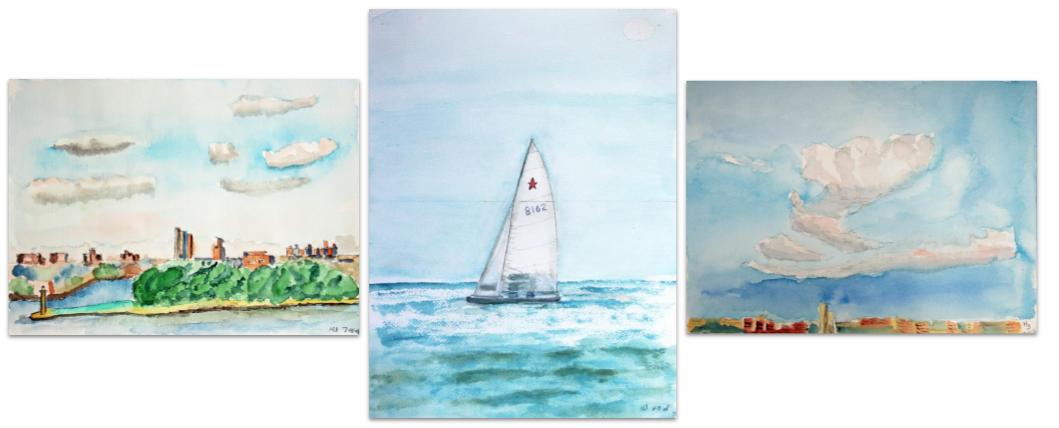
There is a flame of creativity that flickers within us all. A burning compulsion to grow, make, build, program, write, dance, or sing. It may be the smallest spark or a roaring fire, but nonetheless this flame of creativity warms the soul. This warmth nurtures us, bringing peace and healing.
Foreward:
This episode is a pretty big departure from the normal “structure” of Beyond the Frame. This is for a few reasons, and I want to share those with you. I like to try to give extra context with these blogs when I can and this is an episode that I think deserves a little extra context.
First: The Beyond the Frame team and I really try to develop these episodes in a way that allows us to “test” new ways of storytelling and see what our audience responds to best. That’s why we really appreciate ALL feedback we get! The structure of this episode focuses more on the story of the artist and his body of work rather than the story of one piece.
Second: When I learned of Horace’s story, I immediately gravitated towards it. No spoilers, but Art is something that has always brought me great comfort.
I’ll add another thought at the end, but like I said – No Spoilers!
He Would Just Sketch
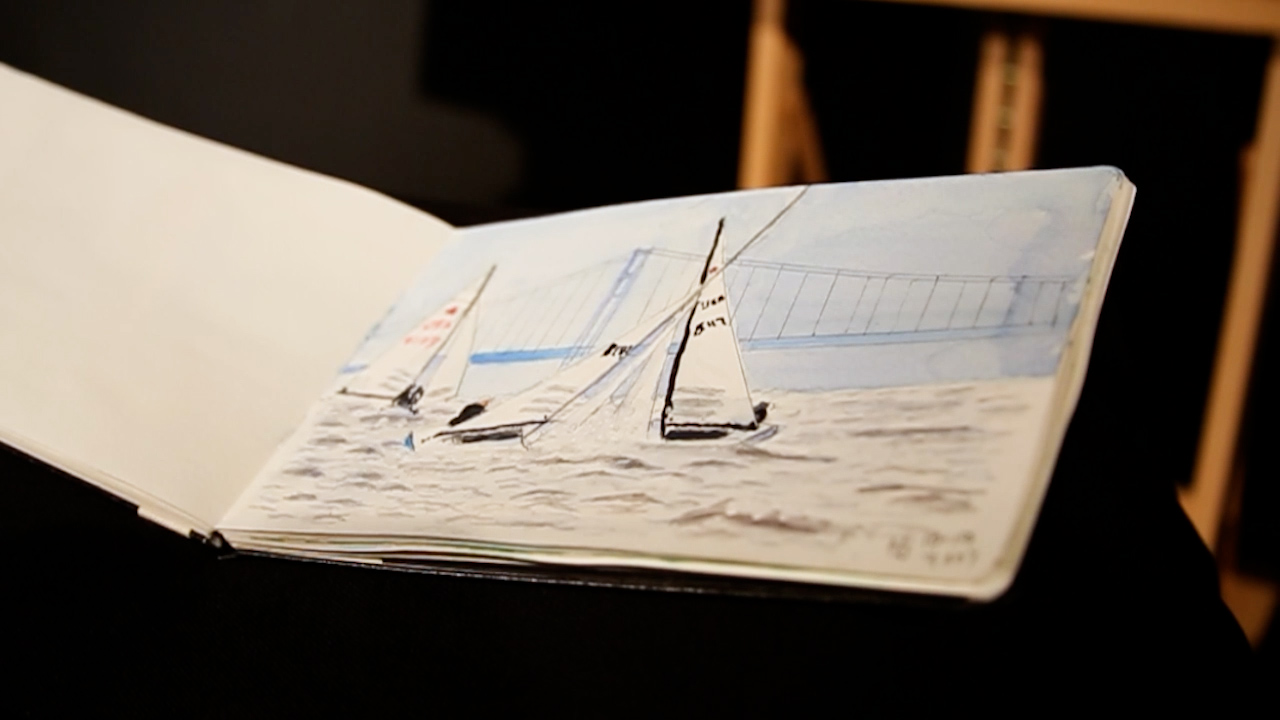
Horace Havemeyer III was a man whose creative flame burned strong and steady. He was constantly compelled to create and though he was always entwined with the arts, he was not a full-time artist. I had the pleasure of getting to interview Mrs. Eugenie C. Havemeyer, Horace’s wife, and when describing Horace and his drive to create, she said “He was brilliant, he had a very fertile mind and he was always thinking about things… thinking about them visually and so he would just sketch.” She recounted to me how, even since childhood, Horace kept a notebook close at hand sketching and doodling, even in the margins, as this spark of inspiration flickered.

A Story Told Through Art
Looking through his notebooks, we get to see a story of Horace’s life and the sparks that compelled him to create, one of which was a lifelong love of the water. A connection to the water. We also see a story of a rare illness, of perseverance, loss, and finding solace and warmth in art and the act of creation.
In the late 1990’s, when Horace was 58, he was diagnosed with Chronic Inflammatory Demyelinating Polyneuropathy, an autoimmune disorder that caused peripheral neuropathy, which ultimately led to total paralysis before his passing in 2014. But the bold life he lived was dedicated to creation and it’s clear he was compelled to create by the wonder of the world around him.
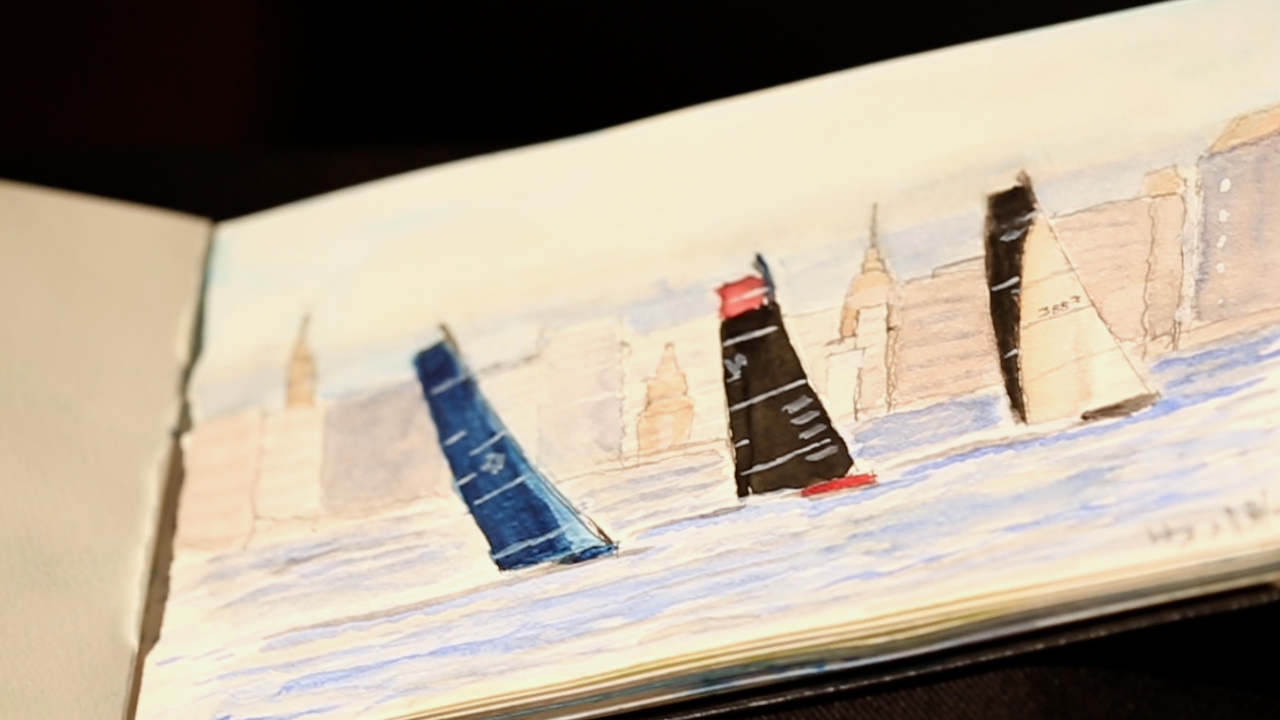
Finding Solace and Inspiration in Water
From childhood he loved sailing, watching races, and being on the water, a love that continued into his adulthood and one that is reflected countless times in the pages of sketchbook after sketchbook.
Throughout the couple’s life together, their homes were situated on rivers. Horace found solace in looking at the water and would position his desk so that he could look out his window at the river, many times painting the same scene over and over again. This repetition allows us to see the progression of his CIDP over time, lines becoming softer, looser. Brushstrokes of watercolor getting larger and more abstracted.
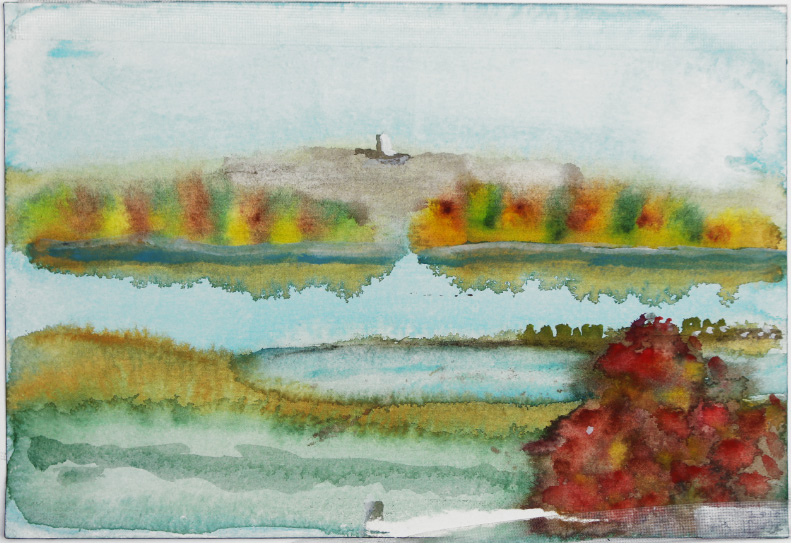
He Could Still Create
Not only do we see the progression of disease, but we see perseverance. In fact, in looking at his works chronologically, Horace’s compositions became more complex, his technical skill improved despite a regression in dexterity.

We see sketches made with his art group that he held on weekends, sharing in a community of art, even as the act of creating became more challenging. But he didn’t stop painting.
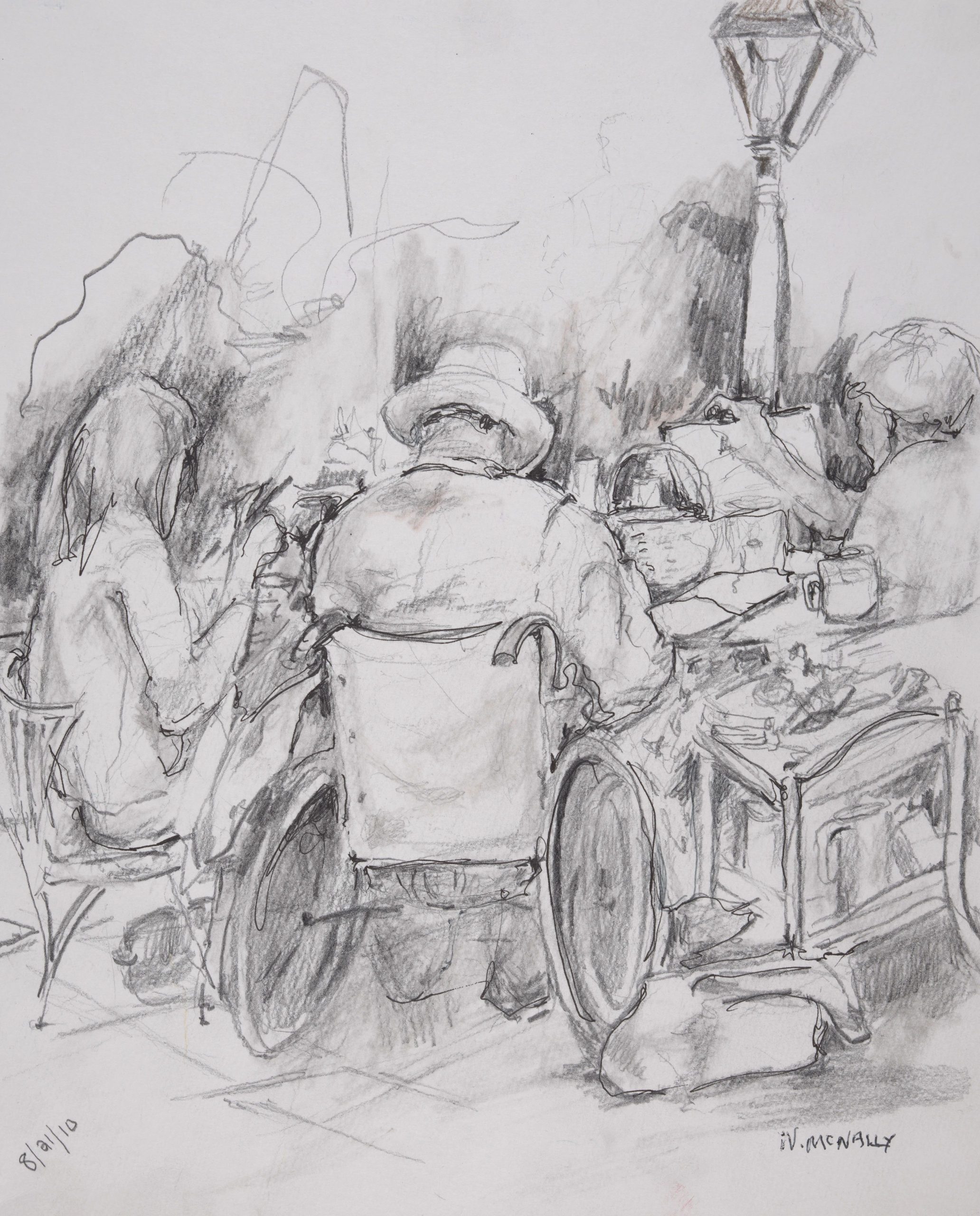
by Nella McNally, Graphite on paper. 2010 . | The Mariners’ Museum and Park 2019.0002.000276
After Horace lost the use of his hands, he continued to create by working with an art therapist, describing the visuals of a scene as she worked to replicate them in collage. When asked what impact art therapy had on Horace, Eugenie proudly and definitively said “He could still create”.

Simply Because He Loved It
One of the things I love most about this body of work is that it may have never been intended for anyone, other than friends or family, to see or display. It was simply something Horace did because he loved it. Because it sparked joy and fanned that flame in him. Because even as his physical abilities regressed, he knew and felt the power that art has. And art therapy empowered him and continued to give him the ability to heal his soul through creation for the remainder of his life.
Everything
So whether you choose to share it with the world or not, I urge you to seek creation. To find that spark and fan it. To paint what you love, dance wildly, and sing loudly, to explore for yourself the incredible therapeutic powers of art.
The following is an excerpt from my interview with Mrs. Eugenie C. Havemeyer that truly touched me.
Kyra: “Could you tell me about what art and art therapy meant to Horace?”
Eugenie: “Everything.
It meant everything.
It was so much a part of his life, his being, and our being together”
Afterward:
As I mentioned at the beginning, I wanted to bring more context to this episode:
In the spirit of bringing vulnerability and openness to these episodes, I want to share one of the reasons I was so drawn to Horace’s story. My paternal grandfather, Herbert Rice or as I knew him- “Bops”, had Multiple Sclerosis. He passed when I was in 6th grade, but I fondly remember trips to visit him and my Meme, and getting to visit with him. I believe that seeing my Bops’ battle with MS firsthand allowed me to partially understand the truly incredible strength that both he and Horace had in battling these unforgiving diseases.
For myself, Art has always been a comfort. Being amongst works of art is like being amongst friends and while I’m not technically talented, the act of creating – whether its gardening, DIY home projects, etc. always has a way of making me feel better. Less stressed and more accomplished. Like I, in my own tiny way, just for myself, brought a little bit of beauty to this world.
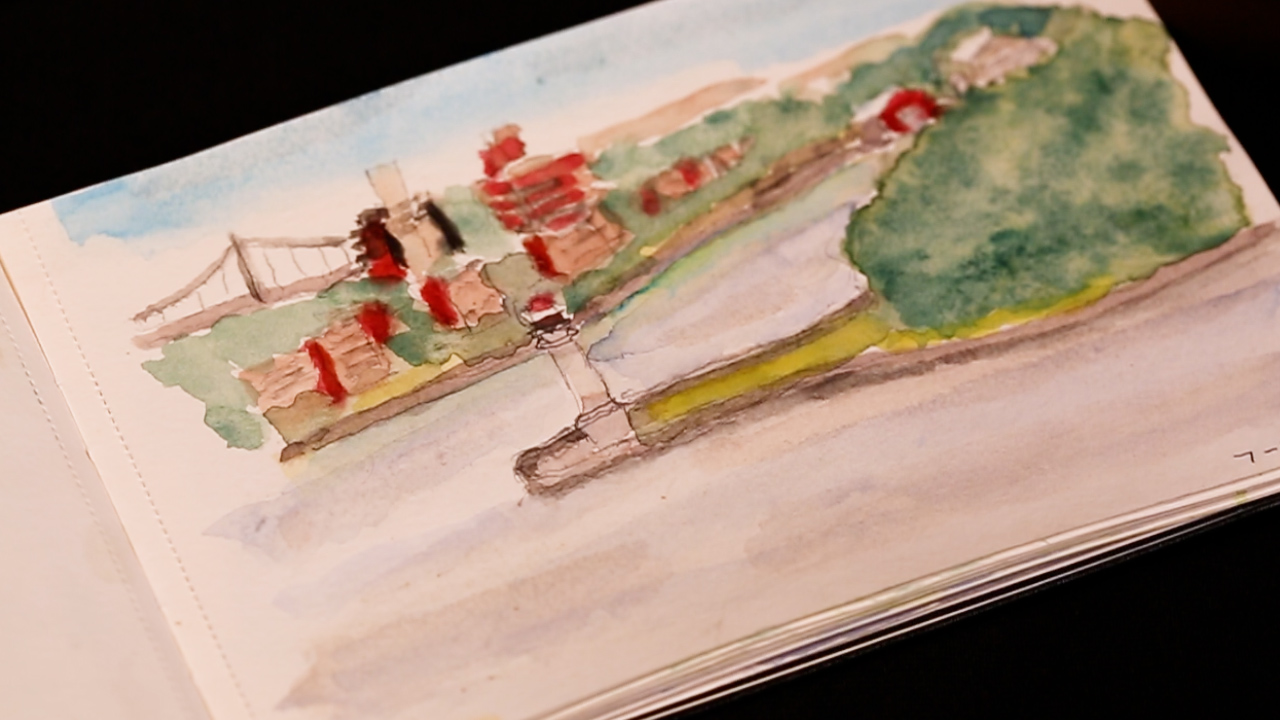
There are trees and on the shoreline are buildings with a bridge in the distance. Notebook #7, Watercolor #14. | Photo by Kyra Duffley/The Mariners’ Museum and Park
Be sure to watch the full episode here and stay tuned for new episodes the first Friday of each month!